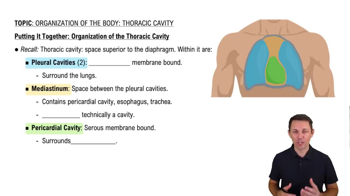Here are the essential concepts you must grasp in order to answer the question correctly.
Respiratory Mechanics
Respiratory mechanics refers to the physical principles governing the movement of air into and out of the lungs. It involves the actions of the diaphragm and intercostal muscles, which, when contracted, expand the thoracic cavity, allowing air to flow into the lungs. Understanding these mechanics is crucial for analyzing how changes in thoracic cavity dimensions affect breathing.
Recommended video:
Internal Regulation - The Myogenic Mechanism
Thoracic Cavity Dynamics
The thoracic cavity is the chamber within the rib cage that houses the lungs and heart. When the inspiratory muscles contract, the thoracic cavity's volume increases, leading to a decrease in internal pressure, which facilitates air inflow. Recognizing how the dimensions of the thoracic cavity change during inspiration is essential for understanding respiratory physiology.
Recommended video:
Organization of the Thoracic Cavity
Inspiration Process
Inspiration is the process of taking air into the lungs, primarily driven by the contraction of the diaphragm and intercostal muscles. This contraction increases the thoracic cavity's volume, resulting in a pressure gradient that draws air in. A clear grasp of the inspiration process is vital for interpreting the effects of muscle contraction on thoracic cavity size and respiratory function.
Recommended video:
Ventilation and Respiration
 Verified step by step guidance
Verified step by step guidance


